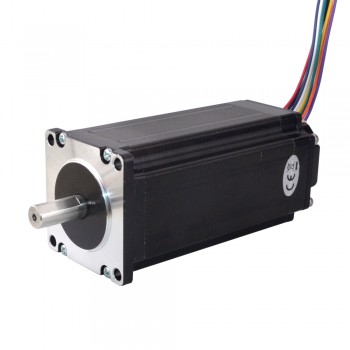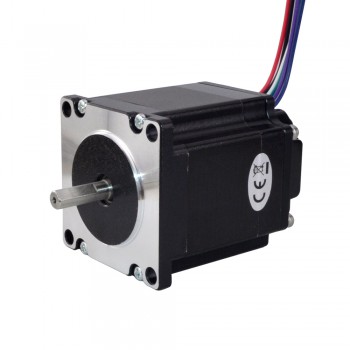Design ideas of integrated stepper motors
1.A brief introduction to integrated stepper motors
An integrated stepper motor is an electromechanical device that integrates a stepper motor, a driver, a motion controller, and an encoder into a whole. This integrated design not only reduces space occupancy, but also greatly reduces wiring work, improving the reliability and practicality of the system. The integrated stepper motor has achieved a space reduction of more than 40% through an integrated design, while reducing wiring work by more than 50%. It has good electromagnetic compatibility characteristics and simplifies the system topology, thereby improving the overall performance and efficiency of the stepper system.
2.Control mode of integrated stepper motors
1.Pulse control: This is the traditional way to control the position and speed of stepper motors. The rotation distance depends on the number of pulses, and the speed depends on the pulse frequency. The three common pulse control methods include pulse direction type, CW/CCW pulse type, and A/B orthogonal pulse type. Each method controls the rotation direction and speed of the motor through different signal inputs.
2.Analog control: The stepper driver supports speed control and position control based on analog signals, and the stepper servo also supports torque mode based on analog signal control.
3.Fieldbus control: The stepper drive supports a variety of industrial fieldbuses, including RS-485, Modbus, CAN, Ethernet, and EtherCAT, making it easy to integrate stepper motors into various industrial control systems.
4.Program resident mode: By executing stored programs to complete complex single-axis motion control, Q-type drives can store and run up to 744 Q program instructions in non-volatile memory. These instructions provide functions such as multitasking, mathematical operations, conditional processing, and data register operations, making the control of stepper motors more flexible and efficient.
3.Selection requirements for integrated stepper motors
1.Determine load and performance requirements: Analyze the nature of the load (linear or rotary), weight, and torque requirements. Consider the maximum and minimum operating speeds required in the application. Determine the required step angle. High-precision applications may require a smaller step angle or use microstepping drives.
2.Motor size and torque: Select the appropriate motor size and mounting interface to ensure compatibility with the mechanical system. Evaluate the maximum static and dynamic torque required, and consider additional requirements during starting, stopping, and acceleration.
3.Electrical requirements: Select the appropriate motor voltage and current according to the control system and power supply capabilities.
Consider the configuration of the motor windings, such as bipolar or unipolar.
4.Compatibility and integration: Make sure the motor is compatible with the controller, including the interface type and control signal.
Consider whether additional components are required, such as reducers, encoders, etc.
5.Debugging methods: The debugging of stepper motors includes determining the required motor torque, determining the operating voltage and current from the motor model and application, and selecting the corresponding driver model according to the motor's operating current and voltage. Consider that the stepper driver cannot have overvoltage problems during sudden braking.

4.Design ideas for integrated stepper motors
1.Select the appropriate stepper motor type: Select the appropriate stepper motor type according to application requirements, such as reactive stepper motors, permanent magnet stepper motors, etc. Each type has its specific advantages and applicable scenarios, so choosing the right type is the first step to a successful design.
2.Design control system: The control system of the stepper motor is its core part, and a control logic that can accurately control the operation of the motor needs to be designed. This includes setting parameters such as acceleration, deceleration, starting speed, speed, phase current control (PWM) and step mode. The control system should also support a variety of motion commands, such as accelerating, moving N steps in the command direction, moving to the absolute position along the most direct path, etc., to ensure that the motor can move according to the preset trajectory and speed.
3.Achieve precise position and speed control: In order to achieve precise position and speed control, subdivision technology, current control technology, vector control technology, etc. can be used. Subdivision technology subdivides a complete step angle into multiple smaller steps by improving the drive circuit, thereby improving the smoothness and positioning accuracy of the motor operation. Current control technology accurately controls the current size of the motor winding through an intelligent driver, improves the dynamic performance of the motor and reduces heat and noise. Vector control technology is similar to the control strategy of AC servo motors. By calculating and adjusting the current vector of each phase, the torque output and efficiency of the motor are optimized.
4.Integrated high-speed communication interface: Modern stepper motor controllers use high-speed communication protocols (such as CANopen, EtherCAT, etc.) to achieve efficient data exchange and real-time control with the host computer. This helps to improve the overall performance and response speed of the system.
5.Apply intelligent algorithms: Use advanced control algorithms such as PID control, fuzzy logic control, and adaptive control to improve the dynamic response of the stepper motor and reduce vibration and step loss. The application of these algorithms can improve the intelligence level of the system, enabling it to better adapt to different working environments and task requirements. In summary, the design ideas of integrated stepper motors involve selecting the right motor type, designing an effective control system, achieving precise position and speed control, integrating high-speed communication interfaces, and applying intelligent algorithms. These steps together ensure the performance and reliability of the stepper motor system and meet the needs of various applications.
Source:https://blog.aujourdhui.com/tianqiong2019/2707079/design_ideas_of_integrated_stepper_motors.html
